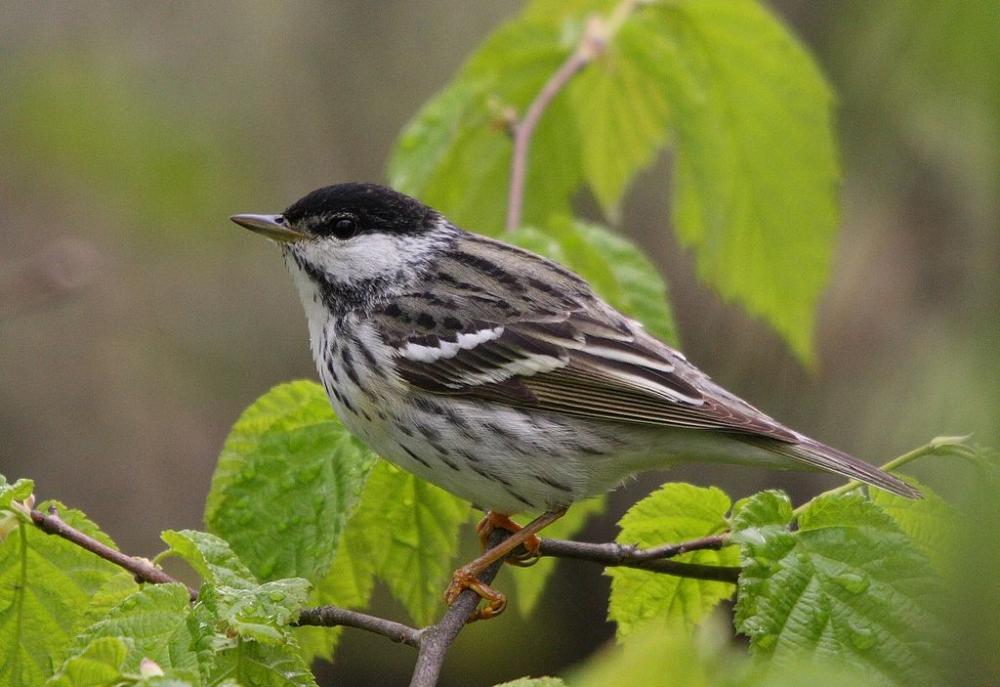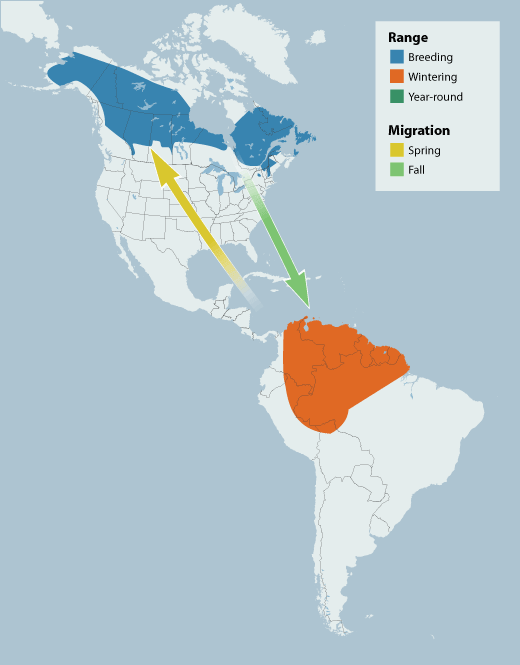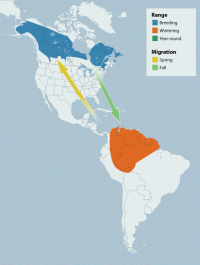Guide to Boreal Birds
This is an in-depth boreal species profile.
What is this?
This species is one of more than 30 birds selected for in-depth profiles. Find out why and see all selected boreal birds »
Overview
The Blackpoll Warbler, named for the black forehead and crown of the breeding male, is a species of superlatives. It has one of the highest pitched songs of any bird and the longest migration of any North American warbler, including almost unimaginably long, nonstop, transoceanic flights. It shows unusually high degrees of polygyny, female site fidelity, and double-brooding for a warbler. It is one of the most common warblers in the East during migration and has an enormous breeding range in the northern part of the continent. During migration in late May, and again in September and early October, dozens may be seen in a single day. It is rarely seen west of the Rockies in spring; however, in fall small numbers of mostly young birds occur regularly along the Pacific Coast. Like all wood warblers, these birds migrate at night; sometimes large numbers, attracted to bright lights on overcast or stormy nights, collide with such obstacles as lighthouses, television towers, and tall buildings. Despite the fact that it is often one of the most common species on its breeding grounds, little is known of its reproductive ecology, particularly in the inaccessible heart of its range. It is one of the harder songbirds to monitor, so its population status is largely a mystery.
Description
5 1/2" (14 cm). Breeding male gray streaked above, with black cap, white cheeks and underparts, blackish streaks on sides. Female and nonbreeding male greenish above with vague streaking, yellowish green below. Feet usually pinkish. See Bay-breasted Warbler.
Voice
Rapid series of high lisping notes all on 1 pitch, increasing and then decreasing in volume; seet-seet-seet-seet-seet-seet-seet-seet.
Nesting
4 or 5 brown-spotted white eggs in a twig-and-grass nest, often lined with feathers and usually placed in a small evergreen tree.
Habitat
The Blackpoll Warbler utilizes a variety of habitats across its broad breeding range. In Alaska and western Canada it occupies spruce-alder-willow thickets. In northern Canada it is found primarily in Boreal black spruce forest. In southeastern Canada and the northeastern U.S., it prefers coastal and subalpine spruce-fir forests with either low or high (but rarely intermediate) densities of large trees. Subalpine populations also use second-growth scrub and woodland as well as forests of conifers mixed with birches or aspens. On migration it shows up in an even wider variety of habitats, including gardens, mangroves, and savannas, though it seems to prefer spruces and alpine habitats where available. In winter it occurs in essentially any low-to-mid-elevation wooded habitat; potential habitat preferences on the winter grounds have not been studied.
Range/Migration
It appears that most Blackpoll Warblers from both eastern and western breeding populations leave North America in fall along the Atlantic coast from Nova Scotia to North Carolina. They depart after cold fronts during periods of northwest winds in October, which help push them southeast over the ocean to the tropics south of Bermuda, where northeast trade winds deflect them south to South America. This entails a nonstop flight of up to 3,500 km (2,175 miles) and 88 hours. Studies have shown that this species has an exceptional ability to accumulate and retain fat, apparently an adaptation for such sustained flights. Some birds, probably mostly immatures, follow the coast south through Florida and then cross the Caribbean. The total trip may exceed 8,000 km (4971 miles) from breeding grounds in Alaska to wintering grounds in Brazil. Spring migration follows a more westerly route. Birds depart South America during the first few weeks of April, cross the western Caribbean, and continue north through the eastern U.S., reaching the breeding grounds in May. It is unknown whether or not most northbound birds travel nonstop over the Caribbean.
Breeding
The Blackpoll Warbler nests from western Alaska across the boreal region and along the boreal forest/tundra transition zone to Newfoundland, northern Nova Scotia, and the mountains of northern New England, with isolated populations in the Adirondacks and Catskills. Canada's boreal forests account for about 65% of the species' population. The following information is based largely on a study in New Brunswick, the source of most of what we know of this species' breeding ecology. Within age classes, males arrive well ahead of females, and adults of each sex arrive up to two weeks ahead of yearlings; some adult females arrive ahead of yearling males. Pairs form shortly after females arrive; both sexes often return to the previous year's territory, so re-pairings are common. Adult females returning to familiar sites not yet claimed by males often mate with neighboring adult males, even already paired ones, rather than waiting for younger males to arrive; the loss of male contribution to the nesting process (normally limited to feeding young) apparently is offset by being able to nest early in high-quality sites. Nest building begins in late May; the cup nest is typically placed against the trunk in dense cover on a low conifer branch. The 4-5 eggs are incubated about 12 days and the young fledge at only 8-10 days of age, well before they are able to fly effectively. They are fed entirely by the parent(s) for another eight days and remain somewhat dependent for an additional two weeks or more. Mated females usually begin second nests right away and leave post-fledging parental duties to their mates. The high incidence of double brooding, coupled with (and partly a function of) low nest predation and parasitism rates, results in high annual productivity for this species.
Diet/Feeding Behavior
The Blackpoll Warbler's diet is primarily arthropods year-round, supplemented by some fruit and seeds, especially during fall migration. The species appears to be quite a generalist, preying on a great diversity of adult and larval insects and spiders. Documented insect prey includes lice, locusts, cankerworms, mosquitoes, webworms, ants, termites, gnats, aphids, and sawflies. It has been suggested that this species may be a spruce budworm specialist, but there is no obvious connection between population trends of the two species. It typically gleans prey from foliage or twigs, typically on the inner portions of mid-level branches of large conifers. It also uses snags and deciduous trees when present and catches some prey by hovering and hawking. It has been observed eating nectar and/or pollen in winter.
References
Blancher, P. 2003. The importance of Canada's boreal forest to landbirds. Canadian Boreal Initiative [Online].
Cherry, J. D., D. H. Doherty, and K. D. Powers. 1985. An offshore nocturnal observation of migrating Blackpoll Warblers. Condor 87:548-549.
Eliason, B. C. 1986. Female site fidelity and polygyny in the Blackpoll Warbler (Dendroica striata). Auk 103:782-790.
Hunt, P. D., and B. C. Eliason. 1999. Blackpoll Warbler (Dendroica striata). In The Birds of North America, No. 431 (A. Poole and F. Gill, eds.). The Academy of Natural Sciences, Philadelphia, and The American Ornithologists' Union, Washington, D.C.
McNair, D. B., and W. Post. 1993. Autumn migration route of Blackpoll Warblers: evidence from southeastern North America. J. Field Ornithol. 64:417-425.
Morse, D. H. 1979. Habitat use by the Blackpoll Warbler. Wilson Bull. 91:234-243.
Murray, B. G., Jr. 1989. A critical review of the transoceanic migration of the Blackpoll Warbler. Auk 106:8-17.
Nisbet, I. C. T., D. B. McNair, W. Post, and T. C. Williams. 1995. Transoceanic migration of the Blackpoll Warbler: Summary of scientific evidence and response to criticisms by Murray. J. Field Ornithol. 66:612-622.
Roberts, R. E., and C. V. Tamborski. 1993. Blackpoll Warbler mortality during fall migration at a tower in southeastern Florida. Fla. Field Nat. 21:118-120.
Sauer, J. R., J. E. Hines, and J. Fallon. 2004. The North American Breeding Bird Survey, Results and Analysis 1966 - 2003. Version 2004.1. [Online]. USGS Patuxent Wildlife Research Center, Laurel, MD.
Credits
Birding content provided by National Wildlife Federation/eNature, with support from Ducks Unlimited/The Pew Charitable Trusts.





